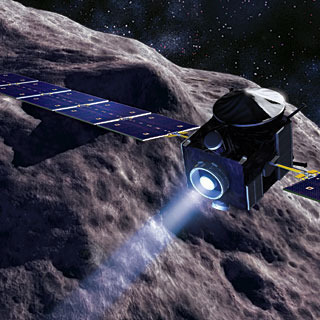Ion Propulsion
Ion propulsion refers to a method of space travel in which accelerating ions, rather than traditional chemical rockets, speed up a spacecraft. While ion propulsion produces very little thrust in comparison to chemical propulsion, it produces consistent acceleration that allows the spacecraft to eventually travel faster than a chemical rocket would. Ion propulsion requires an environment with no radical ions, which means that it cannot be used for air travel, and only works well in interplanetary travel due to its exponential acceleration. Ion propulsion also requires a rather large amount of electricity, although attaching large solar panels to the spacecraft can partially remedy this problem.
How does Ion Propulsion Work?
There are many different ways of producing ionic propulsion. However, using electric and electromagnetic fields is the main method. Generally, an ion propulsion engine containing hydrogen, argon, ammonia, or nitrogen directs the gas through an electric field that ionizes it or gives it a positive charge. An external mechanism or the gas itself (in the form of plasma) creates a magnetic field in the opposite direction of the electric field. Because the electric and magnetic fields are crossing over each other, they act as a positively charged shields that repel the ions out of the rear of the spacecraft, propelling it forward through space.
History of Ion Propulsion
Robert H. Goddard first recorded the idea of ion propulsion at Clark University in a handwritten notebook on September 6, 1906. Goddard experimented with ion propulsion briefly while there and eventually made recommendations for the practical use of ion propulsion. He stated that it would be ideal for near-vacuum, high altitude travel. However, it was not until 1959 that Harold R. Kaufman created the first working ion propulsion engine at the NASA Glenn Research Center. There was a successful 31 minute suborbital flight aboard the SERT 1 (Space Electric Rocket Test 1) in 1964. Since then, many successful tests and missions such as satellite adjustments and propelling objects far into space have been carried out.
Types of Ion Propulsion
While there are many different methods of ionizing particles, there only two major types of ionic propulsion: electrostatic and electromagnetic. Electrostatic ion propulsion engines push particles in the direction of an electric field and eject them into space. Electromagnetic ion propulsion engines, however, use both electric and magnetic fields to ionize particles.
The Future of Ion Propulsion
Though ion propulsion has been in the making for over thirty years, it has a very promising future. The space exploration industry has made many breakthroughs over the past few years in spacecraft design, ion production, and practical deployment of ion propulsion engines. Currently, there are plans to use ion propulsion in an upcoming manned-mission to Mars, bringing the total travel time down from six months to six weeks. Coupled with other revolutionary technologies and private companies that are serious about space exploration (including deep space missions, interplanetary travel, and space hotels), ion propulsion will soon replace traditional chemical propulsion in space altogether.


Comments - No Responses to “Ion Propulsion”
Sorry but comments are closed at this time.